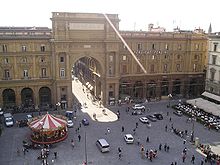Piazza della Repubblica (Florence)
The Piazza della Repubblica in Florence is a right-angled square in the historic center of the city, measuring around 75 × 100 m, which is a typical example of the urban “renovation efforts” of the short capital city period between 1865 and 1871 and the subsequent founding period .
history
The city center, the meeting point of the axes Cardo (today via Roma, via Calimala and via Por Santa Maria), as well as Decumanus , today Via del Corso, Via degli Speziali and Via degli Strozzi was located here as early as Roman times . In the Middle Ages, the Piazza del Mercato Vecchio and the ghetto were located here .
The Mercato Vecchio was a low, elongated building. Duke Cosimo I settled the city's Jews here in the 16th century. There was an Italian synagogue and a Spanish or Levantine synagogue in the ghetto. There were also numerous smaller churches in the area. Only the Colonna della Dovizia or Colonna dell'Abbondanza , which is considered to be the “center of the city”, remains of this medieval ambience .
From 1865 onwards, the district was “redeveloped” based on the French model in the spirit of Georges-Eugène Haussmann . The main focus of the remodeling was in the decade from 1885 to 1895. A number of significant historical buildings were sacrificed during this key period in Florence's recent history .
On the east side of the square is the famous literary café Caffè Le Giubbe Rosse .
The "renovation"
Medieval towers, churches, aristocratic palaces etc. had to give way to urban modernization efforts. In 1890, an equestrian statue of Vittorio Emmanuele II was unveiled, after whom the newly created square was originally named (although it was later transferred). The surrounding buildings, built in the style of historicism , come from fashion architects of the time such as Vincenzo Micheli , Luigi Buonamici , Giuseppe Boccini . As a result, the piazza with its representative hotels, cafés such as the Caffè Paszkowski , department stores and other modern facilities became a popular meeting place for the city's bourgeoisie. A triumphal arch, called "Arcone" (architect Micheli) proudly refers with its inscription to the redevelopment work mourned by many:
- L'ANTICO CENTRO DELLA CITTÀ
- DA SECOLARE SQUALLORE
- A VITA NUOVA RESTITUITO
(roughly: THE OLD CITY CENTER / AFTER CENTURIES OF MISSION / REWARNED TO NEW LIFE. The expression squallore is a strongly negative one, arouses associations with darkness and dirt).
At the top of the arch there were three allegorical female figures until 1904, intended to symbolize Italy, art and science.
More pictures
literature
- Francesco Cesati, La grande guida delle strade di Firenze , Newton Compton Editori, Roma 2003.
- Piero Bargellini , Com'era Firenze 100 anni fa , Bonechi editore, Firenze 1998.
- Accademia delle arti del disegno (ed.): Il Disegno della città: l'urbanistica a Firenze nell'Ottocento e nel Novecento exhibition catalog, Florence November – December 1986










